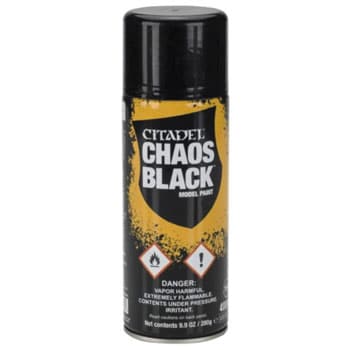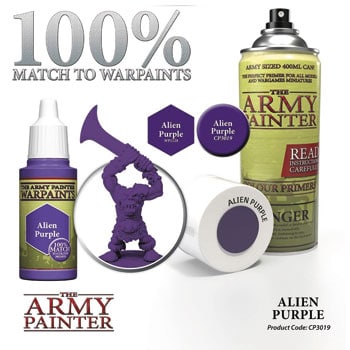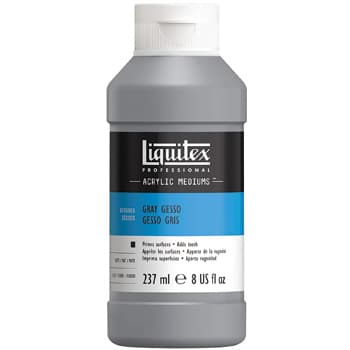To understand the best primer for miniatures let’s first look at what primer is. Primer is a paint with which you prepare the surface before painting. It helps you achieve a smooth and pleasing finish on your models and removes the oily film that can make it difficult to adhere paint to plastic or metal surfaces. There are various types of primers such as ones that are meant to be sprayed and others including those specifically made for plastic models.
Five Primers for Miniatures
- Best Primer for Scale Models: Vallejo Surface Primer VJ73602
- Dries Fastest: Games Workshop – Citadel Chaos Black Primer
- Best Acrylic Spray Primer: The Army Painter ARM03019
- Best Primer for Heat Sensitive Painting: Rust-Oleum 249846
- Best Primer for D&D minis: Tamiya Surface Primer TAM87042
- Budget Pick: Liquitex Neutral Gray Gesso
I love to paint my miniatures. A hobby is a great way of expressing your creativity. This article goes through the research we did in our quest to find the best primer for miniatures!
1. Vallejo Surface Primer VJ73602 – Best Primer for Scale Models
Vallejo Surface Primer is a fantastic acrylic product used for creating an ideal surface for your miniature painting projects. This can be applied either on a primed surface or bare plastic, resin, metal, and wood. It dries in just 4 hours, making it easier to work with compared to other products.
The primer gives the surface of your miniature a solid base to which you can apply your paint, thus producing the best possible finish. Vallejo Primer is a type of acrylic polymer emulsion. It requires no mixing, so it’s simple to apply and use. It dries quickly, and you can use it on both plastics and metals as well as on almost any kind of material used in miniatures.
This Primer is available in bottles with an eyedropper-style applicator for precisely dispensing the product with each use. Shelf life of up to 2 years if unopened and stored correctly under normal conditions.
2. Games Workshop – Citadel Chaos Black Primer – Dries Fastest
This is a very nice spray primer, and I have been using it for years. I have found that it sprays smoothly and leaves no visible brush strokes once dry. The primer has a flat finish which I prefer over a shiny one. It dries quickly to the touch but takes 24 hours or so to fully harden. It appears to be compatible with most Citadel paints, as well as other brands of paint.
It’s easy to control where the primer goes, but you do have to make sure you are applying it in an area where there will be no overspray. One of the best things about this product is that it comes in matte black, which is not something you can find with many other products.
3. The Army Painter ARM03019 – Best Acrylic Spray Primer
I’m not sure what to say about this product. I mean, it’s a miniature primer and sprays paint in the same can. How cool is that? You don’t even have to worry about priming the model before you paint it because the primer can do it all at the same time.
You know… I don’t wanna sound like a broken record but you should probably prime your miniatures before painting them. It’s just good practice. Let this miniature primer be your lazy friend when it comes to doing that.
I think I’ve made my point clear enough that this stuff is cool and useful to any miniature painter. Now go out there and buy some cans of it!
4. Rust-Oleum 249846 – Best Primer for Heat Sensitive Painting
The Touch 2x Ultra Cover, Flat Black Primer has a low odor which is great because you won’t have to worry about burning your eyes out or annoying your neighbors.
The paint dries with a flat finish and is an excellent primer for just about anything. If you’re looking for the best primer for miniatures, be it a toy soldier or for use in tabletop gaming like Warhammer 40K, then this is it!
The product itself is oil-based which makes it ideal on wood, resin, metal, and ceramic. The reason oil-based paints are best on these materials is that they don’t require any type of water to activate them, unlike acrylics and latex-based paints which need moisture from either water or another source to work properly.
5. Tamiya Surface Primer TAM87042 – Best Primer for D&D minis
Tamiya Primer primer is an extremely fine, very smooth primer that has been specially developed for use with plastic models. It dries quickly to a matt finish and is highly resistant to yellowing, so it can be applied to any kind of model whether the original material is plastic or resin.
Tamiya surface primer can be applied with any conventional airbrush or air source, or it can be brushed onto the model using a soft brush. The paint dries quickly to a matt finish and is highly resistant to yellowing.
TAM87042 is an enamel-based primer which makes it a durable choice for plastic and metal models.
6. Liquitex Neutral Gray Gesso – Budget Pick
I am a big fan of Gesso. I use it as a primer for all my miniatures, and I have been using Liquitex Gesso for years. The price is right, the coverage is great, and the results are always awesome!
Liquitex Neutral Gray Gesso is just one more tool in your miniature-making “toolbox” that you can use to make your miniatures stand out on the gaming table. I like to think of it as “armor” for my miniatures. It protects them from any scratches or other damage that might occur during handling or transportation. And, it allows me to paint with confidence knowing that my miniature is protected from damage.
Best Tips for Priming Miniatures
The general rule of thumb for choosing a primer is to use an acrylic matte finish primer for plastic miniatures and a gloss varnish for metals or resin miniatures.
There are a few other things you can do to your miniature before applying primer that can make painting a whole lot easier.
First, if you have 3D prints or homemade terrain pieces, give them a light sanding with fine grit. This helps the paint stick to the surface more effectively. If you are using acrylic paints, it’s also worth giving them a coat of gesso before applying primer. Gesso acts as an excellent primer, especially if you are using glossy paints because it will dull them down before they go on the miniature.
The second, 3D print surfaces tend to be very smooth and glossy, so many people want to use a spray-on primer for these items instead of brushing on acrylic primer. I prefer to brush on acrylics overspray on them because I feel like there’s less chance something goes wrong.
Different Types of Primer Application
Here are some tips to apply the primer precisely.
Using an airbrush
Airbrushes are great for applying primer because they offer a very thin and even coat. They are also easy to use. However, airbrush guns can be expensive and you will need to purchase your compressor. So, if you don’t intend on using the gun often, this might not be the best option for you.
Using an aerosol spray can
This is another popular method of application as it allows you to achieve a very smooth finish. However, it can be challenging to get a smooth finish if you are using a brush or roller to apply the paint because there is a chance that some areas of your wall will dry before others which creates an uneven surface.
Using brushes
If you prefer to use a brush, then make sure that you overlap your strokes when applying primer to ensure that all areas of your wall receive an even coat.
How to use Aerosol Spray Can Primers?
Aerosol primer spray cans are often used to prime miniatures, but how do you use them? Primer application tips similar to airbrush primer applications can be used, and it’s important to know where to put the primer and how much of it to use.
Spray a small amount of primer onto the minis can and move the sprayer around the model. This prevents primers from pooling on surfaces in miniatures and helps protect detail in miniatures. Keep this tube at least six to 12 inches from miniatures when spraying. Your goal is to create an initial layer.
Let primers dry before forming the second layer. The ideal temperature for prime miniatures using aerosol primer can is around room temperatures (76f/24c).
Techniques: Contrast Paints
The contrast paint technique is a great way to show off shades and highlights. When we talk about highlights, we’re referring to the lightest areas of a model. These are usually in the form of edges or recesses on a model. The contrast technique helps bring out these recesses by applying a single thick layer of paint on the highest and lowest portions of the model’s surface. By doing this, you’re able to highlight the features of your model or help bring out its details.
Step 1: Apply primer for miniatures
The first step to using the contrast technique is to apply primer to your miniatures. This will allow you to get the color you want. If you don’t prime it beforehand, then it could be hard for you to get an even color.
Step 2: Apply base coat
The next step is applying a base coat over the entire surface. After applying this base coat, allow it to dry completely before moving on to the next step. Basecoat helps define the colors that you’ll use later on in detailing your model with contrast paint technique.
Step 3: Apply contrasting paint
The third and final step is applying contrasting paint.
FAQ
What color primer should I use miniatures?
It depends on what color you are going to paint the miniature. Black is best for dark colors and white is best for light colors. I use gray because I find it to be an all-purpose primer that covers everything and doesn’t interfere with my ability to see details.
What primer is best for miniatures?
Vallejo Surface Primer. It’s easily accessible, affordable, and flexible. You can use it with a brush or spray paint it on your minis. The great thing about Vallejo Primer is that it’s very easy to apply and dries quickly.
What primer should I use for plastic models?
If you’re looking to protect your miniature and get a smooth, uniform surface, you’ll want to primer your model. And while you can use any paintbrush primer on your plastic model, a spray primer will give you less hassle, as it is easier to apply a thin, even coat.
Do you prime metal models?
For metal miniatures, you want a primer that hardens and for lack of better words, “sticks better” to the metal or resin surface. This means you probably want an enamel-based primer. Enamel is a much harder substance than the polyurethane material of a lot of non-rattle can primers.
Final Thoughts
We chose Vallejo Surface Primer VJ73602 as the best primer for models, thanks to its ability to cover even the darkest of colors like black and red. We liked that it dries quickly and has a great flow to cover large areas. The Citadel Chaos Black Primer is also highly recommended as a cheap solution for miniature painting. The Army Painter primer was called the best acrylic miniature primer because of its quality application even with light pressure, at a budget-friendly price. The Tamiya Surface Primer TAM87042 was named the top primer for D&D miniatures because it is fast drying and sinks into details well. Its counterpart, Tamiya Surface Primer Extra, was awarded an honorable mention for its quality painting capabilities that are nearly identical to its counterpart. If you are looking for the best budget pick on spray primers then look at the Liquitex Neutral Gray Gesso as this product can do anything from model paint to canvas texture.
Ultimately, what works best for you is going to be a subjective decision based on your needs. There are no magic solutions, no tricks that will make it so that one primer consistently beats another in every category – but if you’re looking for the best primer for miniatures, we’ve narrowed your search down a bit with this list of the best primers available today.











